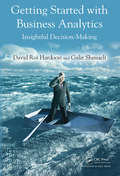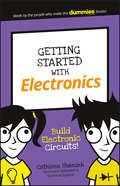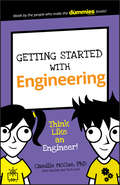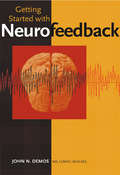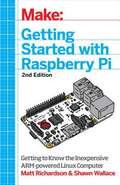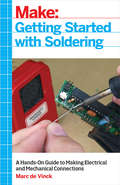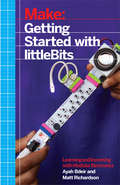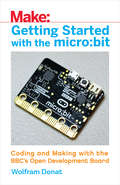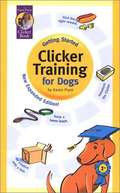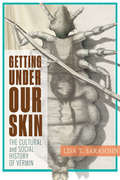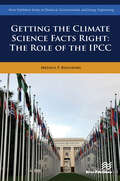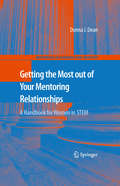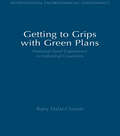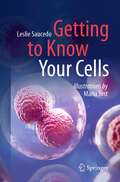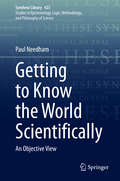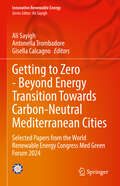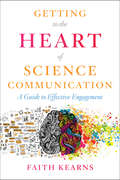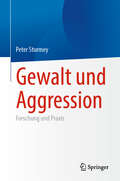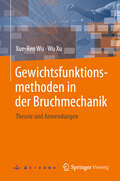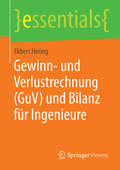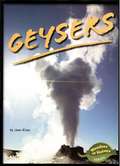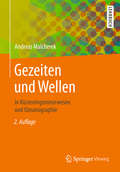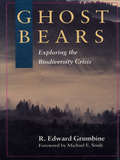- Table View
- List View
Getting Started with Business Analytics: Insightful Decision-Making
by Galit Shmueli David Roi HardoonAssuming no prior knowledge or technical skills, Getting Started with Business Analytics: Insightful Decision-Making explores the contents, capabilities, and applications of business analytics. It bridges the worlds of business and statistics and describes business analytics from a non-commercial standpoint. The authors demystify the main concepts
Getting Started with Electronics: Build Electronic Circuits! (Dummies Junior)
by Cathleen ShamiehFun and engaging electronics projects just for kids! Do you have a cunning kid who's curious about what goes on inside computers, phones, TVs, and other electronic devices? You may just have a budding Edison on your hands—and what better way to encourage their fascination with electronics than a book filled with projects they can complete on their own? In Getting Started with Electronics, your child will follow simple steps to safely create cool electronics projects using basic materials that can easily be found at online retailers or hobby shops. Just imagine your child's delight as they use clips, switches, resistors, capacitors, and more to create circuits that control light and sound! From building a nifty LED flashlight to tuning in to a local radio station using a homemade tuner—and more—your little electronic wiz's world is about to get a whole lot brighter! Features vivid designs and a short page count Focuses on your child experiencing a sense of accomplishment Projects introduce core concepts while keeping tasks simple Teaches electronics in a safe environment Built for the youngest of learners from the makers of the trusted For Dummies brand, you can feel good about giving your child a book that will spark their creativity.
Getting Started with Engineering: Think Like an Engineer!
by Camille MccueFun engineering projects for kids Does your kid's love of 'tinkering' resemble that of a budding Thomas Edison? Then Getting Started with Engineering is guaranteed to spark their fascination! The focused, easy-to-complete projects offered inside are designed to broaden their understanding of basic engineering principles, challenge their problem-solving skills, and sharpen their creativity--all while having fun along the way. Engineers are experts on how things work--and this book is your youngster's best first step to developing the skills they need to think, design, and build things like the pros. The projects they'll complete feature a fun twist that appeal to their age group--from a tiny model roller coaster to a wearable toy that includes an electronic circuit--and the instructions are written in an easy-to-follow manner, making it possible for them to experience the pride and accomplishment of working independently. Appropriate for children aged 7-11 Simple explanations guide children to complete three projects using household items The full-color design, short page count, and easy-to-follow instructions are designed to appeal to kids Brought to you by the trusted For Dummies brand If you have a little engineer that could, Getting Started with Engineering is a great way to encourage their fascination of figuring out how things work.
Getting Started with Neurofeedback
by John N. DemosWhat is neurofeedback? Neurofeedback is founded upon computer technology joined with auxiliary equipment that can measure the metabolic activity of the cerebral cortex. Neurofeedback training combines the principles of complementary medicine with the power of electronics. It is a comprehensive system that promotes growth change at the cellular level of the brain and empowers the client to use his or her mind as a tool for personal healing.Until now, there has not been a single comprehensive yet easy-to-understand guide for clinicians interested in adding neurotherapy to their practice. Getting Started with Neurofeedback is a step-by-step guide for professional health care providers who wish to begin with neurotherapy, as well as experienced clinicians who are looking for a concise treatment guide.This book answers essential questions such as: How does neurotherapy work?, What is the rationale for treatment? When is neurotherapy the treatment of choice? Why should I add it to my already existing healthcare practice? The author also answers questions important to establishing a successful practice such as: What kind of training should clinicians get? What kind of equipment should clinicians buy? How can clinicians add neurofeedback to their existing practice?The first part of the book introduces the reader to the world of neurofeedback, its history and scientific basis. Case studies help clinicians apply what they are learning to their existing practice. Demos takes the mystery out of the assessment process and charts and examples of topographical brain maps (in full color) serve as teaching aids. Later in the book, advanced techniques are explained and demonstrated by additional case studies. The reader is shown how to use biofeedback for the body to augment neurofeedback training as well as being taught to work with the body and acquire a basic knowledge of complementary medicine.The book concludes by offering clinicians practical suggestions on marketing their expanded practice, purchasing equipment, finding appropriate training and supervision, and keeping up with the ever-growing profession of neurofeedback. Research and theory unite to demonstrate the clinical underpinnings for this exciting new modality. Some images in the ebook are not displayed owing to permissions issues.
Getting Started with Raspberry Pi
by Shawn Wallace Matt RichardsonWhat can you do with the Raspberry Pi, a $35 computer the size of a credit card? All sorts of things! If you're learning how to program, or looking to build new electronic projects, this hands-on guide will show you just how valuable this flexible little platform can be. This book takes you step-by-step through many fun and educational possibilities. Take advantage of several preloaded programming languages. Use the Raspberry Pi with Arduino. Create Internet-connected projects. Play with multimedia. With Raspberry Pi, you can do all of this and more. Get acquainted with hardware features on the Pi's board Learn enough Linux to move around the operating system Pick up the basics of Python and Scratch--and start programming Draw graphics, play sounds, and handle mouse events with the Pygame framework Use the Pi's input and output pins to do some hardware hacking Discover how Arduino and the Raspberry Pi complement each other Integrate USB webcams and other peripherals into your projects Create your own Pi-based web server with Python
Getting Started with Soldering: A Hands-On Guide to Making Electrical and Mechanical Connections
by Marc De VinckGetting Started with Soldering not only teaches new makers and experimenters the core principles of soldering, it also functions as an excellent reference and resource for beginners and more advanced makers alike. The book guides readers through the fundamentals of soldering, explains the tools and materials, demonstrates proper techniques, and shows how to fix mistakes or broken connections. It even includes guidance on more advanced techniques such as surface-mount soldering for electronics. From choosing the right soldering iron to making perfect connections, readers will acquire the knowledge and skills needed to form a strong foundation for a lifetime of making.Soldering is a core concept in making, electronics prototyping, and home repairsThe many different types of soldering -- requiring different materials and tools -- are explained with easy-to-follow instructionsFull-color photographs and illustrations throughout create a visually engaging format for learningPricing and technical considerations help readers select the best tools for their budgets and needsTroubleshooting guidelines show how to repair solder connections that have failed from improper technique or from age
Getting Started with littleBits: Prototyping and Inventing with Modular Electronics
by Matt Richardson Ayah BdeirlittleBits are electronic building blocks with over 60 modules and trillions of combinations. With littleBits, anyone can harness the power of electronics, microcontrollers, and the cloud--regardless of age, gender, technical ability, or educational background. You can combine these simple, snap-together, magnetic bricks to make simple electronic circuits, or build robots and devices that combine sensors, microcontrollers, and cloud connectivity. This book, co-authored by littleBits founder Ayah Bdeir, along with top-selling author Matt Richardson (Getting Started with Raspberry Pi), teaches you just enough electronics to start making things with littleBits and takes you on up through connecting littleBits to the cloud and programming with its Arduino-compatible module.
Getting Started with the micro: Coding and Making with the BBC's Open Development Board
by Wolfram DonatThe micro:bit, a tiny computer being distributed by the BBC to students all over the UK, is now available for anyone to purchase and play with. Its small size and low power requirements make it an ideal project platform for hobbyists and makers. You don't have to be limited by the web-based programming solutions, however: the hardware on the board is deceptively powerful, and this book will teach you how to really harness the power of the micro:bit. You'll learn about sensors, Bluetooth communications, and embedded operating systems, and along the way you'll develop an understanding of the next big thing in computers: the Internet of Things.
Getting Started: Clicker Training for Dogs (Revised Edition)
by Karen Pryor"Clicker Training-easy for you, fun for your dog! "Turn your pet into a great dog with easy, all-positive clicker training. Clicker expert Karen Pryor shows you how to use clicks and treats to teach your dog: Good manners, including walking without pulling and sitting to greet Housetraining and obedience Games and tricks "If your dog has been labeled untrainable, if he has been call soft, aggressive, dominant, hard-headed, stubborn, or independent-In short, if you have a DOG-clicker training is the solution you've been searching for." - Melissa Alexander trainer and owner of www.clickersolutions.com; author, Clicker Solutions: The Clicker Training Answer Book "Clicker training is sweeping the nation. It's fun, fast, and positive. A 2-tail salute to Karen Pryor, a trainer who brought clickers to the dog world... " - Sarah Hodgson trainer and author, Dog Tricks for Dummies "With clicker training, a dog begins to understand that his actions influence his environment. With this understanding comes trust and respect for the owner. " - Emma Parsons trainer/behaviorist, Yankee Golden Retriever Rescue; author, Click to Calm: Training to Heal the Aggressive Dog "Karen Pryor's clicker training is the most compelling demonstration of dog training that I have ever seen. No dog should go without this information. " - Dr. Nicholas Dodman, Director, Behavior Clinic Tufts University School of Veterinary Medicine."
Getting Under Our Skin: The Cultural and Social History of Vermin
by Lisa T. SarasohnHow vermin went from being part of everyone's life to a mark of disease, filth, and lower status.For most of our time on this planet, vermin were considered humanity's common inheritance. Fleas, lice, bedbugs, and rats were universal scourges, as pervasive as hunger or cold, at home in both palaces and hovels. But with the spread of microscopic close-ups of these creatures, the beginnings of sanitary standards, and the rising belief that cleanliness equaled class, vermin began to provide a way to scratch a different itch: the need to feel superior, and to justify the exploitation of those pronounced ethnically—and entomologically—inferior. In Getting Under Our Skin, Lisa T. Sarasohn tells the fascinating story of how vermin came to signify the individuals and classes that society impugns and ostracizes. How did these creatures go from annoyance to social stigma? And how did people thought verminous become considered almost a species of vermin themselves? Focusing on Great Britain and North America, Sarasohn explains how the label "vermin" makes dehumanization and violence possible. She describes how Cromwellians in Ireland and US cavalry on the American frontier both justified slaughter by warning "Nits grow into lice." Nazis not only labeled Jews as vermin, they used insecticides in the gas chambers to kill them during the Holocaust.Concentrating on the insects living in our bodies, clothes, and beds, Sarasohn also looks at rats and their social impact. Besides their powerful symbolic status in all cultures, rats' endurance challenges all human pretentions. From eighteenth-century London merchants anointing their carved bedsteads with roasted cat to repel bedbugs to modern-day hedge fund managers hoping neighbors won't notice exterminators in their penthouses, the studies in this book reveal that vermin continue to fuel our prejudices and threaten our status. Getting Under Our Skin will appeal to cultural historians, naturalists, and to anyone who has ever scratched—and then gazed in horror.
Getting a Feel for Lunar Craters
by David HurdThe text from a Braille, tactile book written for visually impaired people to feel what lunar craters are like.
Getting into Graduate School in the Sciences
by Sturdivant S. Kersey Relles Noelle J.Are you applying for graduate school and feeling overwhelmed by the choices available to you and the complexity of the application process? This informative and humorous guide for life and earth science students offers comprehensive advice to help you prepare and increase your chances of success. Adopting a step-by-step approach, you will be guided through the entire application process, from undergraduate preparation and choice of graduate program, to funding, applying, scheduling a visit, and finally deciding which offer to accept. Based extensively on a comprehensive survey of graduate admissions programs across the United States, the advice offered is evidence-based and specific to the natural sciences. This jargon-free text ensures that prospective students are well prepared and make best use of all available resources to convince graduate programs and advisors that you are the best candidate.
Getting the Climate Science Facts Right: The Role of the IPCC
by Medani P. BhandariGetting the Climate Science Facts Right - discusses climate change science with reference to the Intergovernmental Panel on Climate Change (IPCC). Addressing climate change is the most important public priority of the 21st Century. Unlike many issues, however, this issue is being driven by both science and its interface with politics. The main institution for bridging this division between science and international politics is the IPCC. As such it is the main source of the facts from which climate change policy is developed. This book describes the ways in which the IPCC arrives at these facts and so can be sure they are complete and evidence based.Seldom in history has science had such a direct relationship with politics. The negotiation of an international policy regime requires, at its outset, an agreement on the facts. In this case, the facts are scientific, complex and contentious. Governments have recognized this and have, by using the IPCC, set up institutional machinery to provide facts from a source and in a manner that they can accept.The way in which the IPCC functions is unique in that it melds the way in which science achieves consensus with the way governments do at the international level. Starting with a process to examine, review and debate scientific findings leading to a consensus about scientific fact, usually expressed as probabilities that the findings will hold over time, the IPCC then concludes by using the kind of consensus-development mechanism that the United Nations typically uses to achieve agreements leading to the formation of policy regimes.The book examines the structure of the IPCC, its composition and its procedures in order to achieve an understanding of its role and future.
Getting the Most out of Your Mentoring Relationships
by Donna J. DeanTraditionally, scientific research in all disciplines has demanded single-mindedness, exclusive devotion, and aggressive self-promotion. The image of the scientist in the laboratory at all hours of the night and weekend is not far from the reality sometimes demanded. Because of the structure of the science, technology, engineering, and mathematics (STEM) curricula and workplace environment, women often work up to 80 hours per week with little time for outside pursuits - let alone extracurricular reading. Yet, precisely because of these demands, it is imperative that they build solid mentoring relationships. This handbook aims to provide a quick, yet structured guide to mentoring including finding the right mentors, being a good mentee, and making the most out of today's diverse mentoring environments. A handy resource guide will be included for quick reference.
Getting to Grips with Green Plans: National-level Experience in Industrial Countries
by Barry Dalal ClaytonOne of the more significant recommendations to emerge from UNCED in 1992 was the call in Agenda 21 for countries to develop and implement national sustainable development strategies. Most countries have responded to this challenge. However many countries also have a long history of drawing up planning exercises at this level to deal with environmental problems. 'Green planning' is now used as a shorthand term for a range of such national-level planning initiatives covering both sustainable development and environmental concerns, and countries from the North and the South can benefit from a pooling of knowledge. Getting to Grips with Greens Plans presents a cogent analysis of industrial countries' experiences in this area, drawing out lessons and observations from broad empirical experience. Part 1 provides an overview of national green planning, reviewing its origins and scope, identifying popular approaches and common processes, highlighting important issues such as participation, the influence of domestic politics, and the track record of more ambitious regional plans, and comparing approaches in developed and developing countries. Part 2 goes on to present a series of detailed case studies, drawn largely from interviews with key individuals responsible for coordinating national green planning processes. These cases come from a range of Western and Eastern European countries, the US and Canada, and Australia and New Zealand. Some of these case studies show impressive records of achievement, whilst others demonstrate potential stumbling blocks. All demonstrate the difficulty of putting the concept of sustainable development into practice Barry Dalal-Clayton is director of the Environmental Planning Group at the International Institute for Environment and Development, London. In recent years, Dr Dalal Clayton has been deeply involved in analyzing approaches to national sustainable development strategies and environmental action plans in many countries, and in advising governments and international agencies in this field. His other current research interests include environmental impact assessment, community-based wildlife management and land use planning. Originally published in 1996
Getting to Know Your Cells
by Leslie SaucedoThis book acts as a field-guide for human cells. The book’s unique structure first separates cells by what makes them distinctive, and then examines the essential “tools and parts” needed for both the cells’ specialized function, and also the basic mechanisms that are shared with most other cells. The chapters highlight interactions between multiple cell types, exploring areas such as immunology and cancer to exemplify the complex coordination of cells, as well as the manipulation of normal cell interactions. This book works as a companion reference for an academic text in cell and molecular science, and will be of general interest to anyone who wants to learn more about how cells work and interact.
Getting to Know the World Scientifically: An Objective View (Synthese Library #423)
by Paul NeedhamThis undergraduate textbook introduces some fundamental issues in philosophy of science for students of philosophy and science students. The book is divided into two parts. Part 1 deals with knowledge and values. Chap. 1 presents the classical conception of knowledge as initiated by the ancient Greeks and elaborated during the development of science, introducing the central concepts of truth, belief and justification. Aspects of the quest for objectivity are taken up in the following two chapters. Moral issues are broached in Chap. 4, which discusses some aspects of the use and abuse of science, taking up the responsibilities of scientists in properly conducting their business and decision-makers in their concerns with the import of science for society. Part 2 contrasts the view of scientific progress as the rejecting of old hypotheses and theories and replacing them with new ones, represented by Karl Popper, with the conception of progress as accumulating knowledge, saving as much as possible from older theories, represented by Pierre Duhem. A concluding chapter defends the natural attitude of taking the theories of modern science to be literally true, i.e. realism, in the face of arguments drawn partly from the history of scientific progress in criticism of this stance.
Getting to Zero - Beyond Energy Transition Towards Carbon-Neutral Mediterranean Cities: Selected Papers from the World Renewable Energy Congress Med Green Forum 2024 (Innovative Renewable Energy)
by Ali Sayigh Antonella Trombadore Gisella CalcagnoThis book contains selected papers from the World Renewable Energy Congress and Network Forum's seventh edition of the biannual Med Green Forum (MGF2024) that highlight opportunities for energy transition based on the principles of efficiency, urban/building integration, and ecology. Contributions explore possible carbon-neutral solutions, technologies, strategies, processes, and policies for Mediterranean cities. The book addresses the transformation in the unique socio-climatic and cultural context of the Mediterranean basin, cities, and architecture, a transversal topic deeply related to social dynamics and new energy landscapes.
Getting to the Heart of Science Communication: A Guide to Effective Engagement
by Faith KearnsScientists today working on controversial issues from climate change to drought to COVID-19 are finding themselves more often in the middle of deeply traumatizing or polarized conflicts they feel unprepared to referee. It is no longer enough for scientists to communicate a scientific topic clearly. They must now be experts not only in their fields of study, but also in navigating the thoughts, feelings, and opinions of members of the public they engage with, and with each other. And the conversations are growing more fraught. In Getting to the Heart of Science Communication, Faith Kearns has penned a succinct guide for navigating the human relationships critical to the success of practice-based science. This meticulously researched volume takes science communication to the next level, helping scientists to see the value of listening as well as talking, understanding power dynamics in relationships, and addressing the roles of trauma, loss, grief, and healing.
Gewalt und Aggression: Forschung und Praxis
by Peter SturmeyDieses Buch bietet einen prägnanten und umfassenden Überblick über vielfältige Themen im Bereich von Gewalt und Aggression. Es verwendet einen funktionalen Ansatz, der die evolutionären, kulturellen und operanten Faktoren von Gewalt und Aggression darstellt. Das Buch zeigt Entstehungsfaktoren verschiedener Formen von Gewalt und Aggression, erläutert Epidemiologie und Risikofaktoren, beschreibt biologische, kulturelle und individuelle Ursachen und diskutiert individuelle sowie gesellschaftliche Möglichkeiten von Prävention und Therapie. Wichtige Themen umfassen: Epidemiologie von Gewalt und Aggression Biologische und soziale Ursachen von Gewalt und Aggression Kulturelle Interventionen, Psychotherapien und individuelle biologische Interventionen Die Auswirkungen von Gewalt und Aggression in besonderen Bevölkerungsgruppen Gewalt und Aggression: Forschung und Praxis ist eine unverzichtbare Ressource für Forscher, Akademiker sowie Studierende der höheren Semester in forensischer Psychologie Kriminologie/Strafjustiz, Entwicklungspsychologie, Psychotherapie/Beratung, Psychiatrie, öffentlichen Gesundheitseinrichtungen, Sozialarbeit, Bildungspolitik und -wissenschaften, Gesundheitspsychologie, Pflege sowie Verhaltenstherapie und Rehabilitation.
Gewichtsfunktionsmethoden in der Bruchmechanik: Theorie und Anwendungen
by Wu Xu Xue-Ren WuDieses Buch bietet einen systematischen und standardisierten Ansatz, der auf der über 30-jährigen Forschungserfahrung der Autoren mit Gewichtsfunktionsmethoden sowie auf der einschlägigen Literatur basiert. Die Bruchmechanik ist in vielen wichtigen technischen Bereichen zu einem unverzichtbaren Werkzeug für die Auslegung und den sicheren Betrieb von schadenstoleranten Strukturen geworden. Der Spannungsintensitätsfaktor - der charakterisierende Parameter des Rissspitzenfeldes - ist die Grundlage der bruchmechanischen Analyse. Die Gewichtsfunktionsmethode ist ein leistungsfähiges Verfahren zur Bestimmung von Spannungsintensitätsfaktoren und Rissöffnungsverschiebungen für komplexe Belastungszustände mit bemerkenswerter Berechnungseffizienz und hoher Genauigkeit.Das Buch stellt den theoretischen Hintergrund der Gewichtsfunktionsmethoden sowie eine Fülle von analytischen Gewichtsfunktionen und Spannungsintensitätsfaktoren für zwei- und dreidimensionale Rissgeometrien vor, von denen viele in nationale und internationale Normen und industrielle Regelwerke eingeflossen sind. Die Genauigkeit der Ergebnisse wird genauestens überprüft, und es werden verschiedene Anwendungsbeispiele gegeben. Das Buch ist somit ein ideales Nachschlagewerk für Studenten, Forscher und Ingenieure, die sich mit dem Bruch und der Ermüdung von Werkstoffen und Strukturen befassen und nicht nur die Spannungsintensitätsfaktoren selbst, sondern auch effiziente und zuverlässige Werkzeuge zu deren Ermittlung benötigen.
Gewinn- und Verlustrechnung (essentials)
by Ekbert HeringDie Jahresabschlüsse von Unternehmen bestehen aus einer Gewinn- und Verlustrechnung sowie einer Bilanz mit Anlagespiegel und Anhang. Unternehmen, die am Kapitalmarkt agieren, müssen Jahresabschlüsse nach IAS/IFRS (IAS: International Accounting Standard; IFRS: International Financial Reporting Standards) vorlegen und eine Kapitalflussrechnung vornehmen. Die Auswertung dieser Zahlenwerke durch entsprechende Kennzahlen gibt den Kunden, den Lieferanten, den eigenen Mitarbeitern, den fremden Geldgebern und der Öffentlichkeit Einblick darüber, ob die Geschäfte des Unternehmens erfolgreich waren oder nicht, ferner können daraus zukünftige Entwicklungschancen und Risiken abgelesen werden.
Geysers (Fountas & Pinnell LLI Gold #Level R)
by Jean Knox<p>GEYSERS-AN ENDANGERED WONDER <p>Shooting water and steam high into the air, geysers are spectacular. They are also extremely rare. Few places on Earth have exactly the right conditions to produce these amazing natural wonders. <p>Text Elements: <p> <li>Genre: Nonfiction, Expository <li>Text Structures: Main: Categorical, Embedded: Description, Temporal Sequence, Problem/Solution <li>Text Features: table of contents, headings, photos, illustration, captions, pronunciation guide, sidebars, map, diagram, labels, table, glossary, index</li> </p>
Gezeiten und Wellen: In Küsteningenieurwesen und Ozeanographie
by Andreas MalcherekDas Fachbuch vermittelt alle Grundlagen der Hydromechanik am Beispiel der Küstengewässer. Der Autor wendet sich dabei an alle Ingenieure, die sich mit Küstenströmungen im Ökosystem Wattenmeer, Klimafolgen, dem Meeresspiegelanstieg, dem Küstenschutz und Offshoreanlagen beschäftigen.
Ghost Bears: Exploring The Biodiversity Crisis
by R. Edward Grumbine Michael E. SouléIn Ghost Bears, R. Edward Grumbine looks at the implications of the widespread loss of biological diversity, and explains why our species-centered approach to environmental protection will ultimately fail. Using the fate of the endangered grizzly bear -- the "ghost bear" -- to explore the causes and effects of species loss and habitat destruction, Grumbine presents a clear and inviting introduction to the biodiversity crisis and to the new science of conservation biology.
